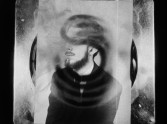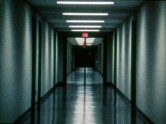
Stella/Frampton and Film:
1958 and Beyond
Program Two
The first film by the innovative West Coast sculptor Bruce Conner, A Movie is an editing tour-de-force, made entirely of scraps from B-movies, newsreels, novelty shorts, and film leader—all combined into a powerful portrait of our culture’s fascination with catastrophe and conquest. Conner’s films are brilliant manipulations whose tone of humor and ambivalence, critique and complicity, make them among the first, best, and brightest examples of the now-ubiquitous found footage film.
Akin to Stella in his role as a major figure whose explorations marked a shift in the history of postwar American art, Stan Brakhage forged a new mode of filmmaking. Anticipation of the Night is a formative work—a prime example of what P. Adams Sitney calls the lyrical film. Both the film and Brakhage’s contemporaneous essay, Metaphors on Vision, bear the marks of a Romantic idealism concerned with the visualization of intense and complex interior states. Anticipation of the Night is in the first person; the protagonist/camera attempts to participate in the untutored vision of a child, but night falls as the man is unable to regain that innocence. “There is seen the sleep of innocents in their animals dreams, becoming the amusement, their circular game, becoming the morning. The trees change color and lose their leaves for the morn, they become the complexity of branches in which the shadow man hangs himself (SB).”
-
Arnulf Rainer
Directed by Peter Kubelka.
Austria, 1958/1960, 16mm, black & white, 7 min.
Although the duration of his output does not exceed sixty minutes of screen time, Peter Kubelka’s influence and impact are significant. In his third film, Arnulf Rainer, Kubelka continues his revival of the graphic traditions of the 1920s, reaching an extreme reductiveness (a montage of black and clear leader, white noise, and silence) to illustrate his theory that “cinema is not movement” but a projection of still images—and that it is not between shots but “between frames where cinema speaks.” Despite dissimilarities between Kubelka’s work and the main texts of structural film, Arnulf Rainer’s minimalist aesthetic gives credence to his claim that he was the precursor of that tradition.
-
Scratch
Directed by Robert Huot.
US, 1966-1967, 16mm, black & white, silent, 11 min.
By the late 1960s, New York artist Robert Huot’s conceptual and minimal paintings were exhibited alongside works by Frank Stella, Larry Poons, and Sol LeWitt. On his regular trips to see triple features on 42nd Street, Huot found himself “fixating on the light dancing in the scratches on the emulsion,” which he often found more interesting than the movies themselves. He began making films soon after becoming friends with Hollis Frampton, who felt Huot was “doing basic work that we film-makers ought to have done for ourselves decades ago, work that is both an addition and a reproach to film art." Scratch is “successful in reducing the number of filmic variables so completely that essential qualities and potentials of the materials of film can be felt. While [it] is nothing more than eleven minutes of dark leader with a continuous handmade scratch, the resulting imagery varies a good deal, depending on how deeply Huot dug into the emulsion (Scott MacDonald).”
Ernie Gehr began making films in the late 1960s, using the medium in a way that expresses his belief that film “is not a vehicle for ideas or portrayals of emotion outside of its own existence as emoted idea. Film is a variable intensity of light, an internal balance of time, a movement within a given space.” Serene Velocity, which established his reputation as a major filmmaker, registers the empty corridor of a university building as Gehr systematically changes the focal length of the zoom lens. The result—a vibrating, pulsing, optical experience—creates a purely cinematic space and time whose illusion of geometric forms expanding out from the center of the screen resonates with Frank Stella’s 1958-1960 Black Paintings.








